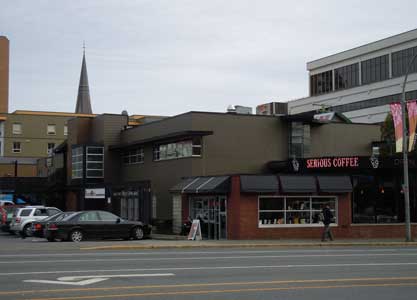Heritage Register
North Park
1609 Blanshard Street
Canadian National Institute for the Blind
Built
1951
Heritage-Registered
For: Canadian National Institute for the Blind
Architect: Frank W. Nicholls & John A. Di Castri

ARCHITECTURE:
The two-storey Canadian National Institute for the
Blind (CNIB) building is a striking Modernist structure,
recognizable for its curvilinear forms and strong horizontal
rooflines. Built in 1951, this building is one of the outstanding
examples of the development of a local stream of
the Modern Movement in Victoria. Designed to resemble a
coastal ferry, the front façade incorporates a rounded window
capped by a canopy with curved, upturned edges, that
visually anchors the building and provides the composition
with a strong focal point. The rear portion of the building
exhibits strong references to the International style with its
plain walls, angular edges and ribbon windows with horizontal
muntins. The use of horizontal massing, contrasting
material and continuity between the interior and exterior
demonstrates an affinity for the contemporary work of
American architect Frank Lloyd Wright.
The institutional form, scale and massing of the
building is expressed by separate square, rectangular and
curved components, capped with flat, floating roof planes
on the front and along both sides. The masonry construction
includes red combed brick, stucco cladding, an angled
concrete entry pier with circular cut-outs, and a stepped
red combed brick wall adjacent to the entry. A projecting,
multi-angled steel-sash stair window is located on the
second floor above the canopy. The curved brick planter
at the front and angled planter at the entry are both capped
with concrete and still extant. Many windows on the left
side and the front have been added. The third
bank of windows on the left side at the rear have
been replaced by a boxed, glassed-in projection.
The CNIB Building is a significant and
early example of the work of architect John Di
Castri (1924-2005), who played a seminal role
in establishing modern architecture in Victoria
during the early postwar years. Designed during
a brief partnership with Frank W. Nicholls,
the CNIB Building illustrates Di Castri’s interest
in the development of a personal brand of
modernism. His work remains distinctive for its
regionalist expression - a rich fusion of materials
and complex, eccentric forms that demonstrates
Di Castri’s interpretation of Wrightian motifs including
horizontal planes, manipulated volumes and irregular
geometry.
This building is significant for its association with the
presence of the CNIB in Victoria. The CNIB was founded
during WWI in 1917 to offer Braille books to veterans who
had lost their eyesight. The institute originally offered
sheltered accommodation and employment. Since that
time the CNIB has expanded into many other service
areas, including public education, research, rehabilitation
training, advocacy and an alternative-format library. This
expansion resulted in the commissioning of 21 new buildings
to provide residences and service centres for veterans
in major cities across Canada between 1940 and 1955.
ORIGINAL OCCUPANTS:
The CNIB operated at 1609 Blanshard St until 1986.
OTHER OCCUPANTS:
Since then the building has been occupied by a number
of different tenants, including Monday Publications, Real
Estate Victoria, Victoria’s Business Report and Serious
Coffee.
ADDITIONAL INFORMATION & IMAGES:
• Map of Victoria Heritage Register Properties
• Statement of Significance (Canadian Register of Historic Places)
• North Park History
• North Park Heritage Register
• This Old House, Victoria's Heritage Neighbourhoods,
Volume Three: Rockland, Burnside, Harris Green,
Hillside-Quadra,
North Park & Oaklands

